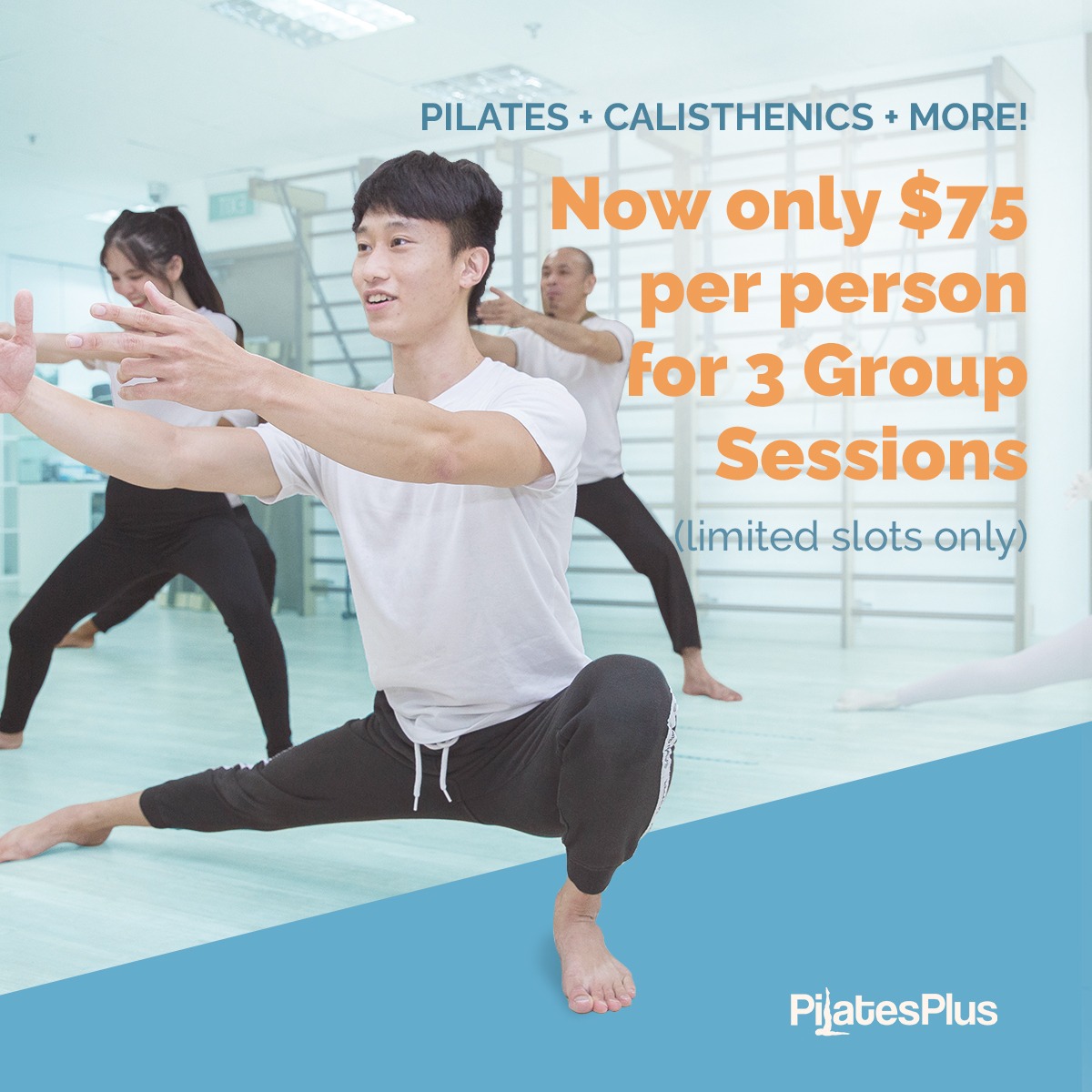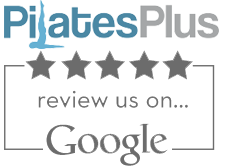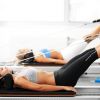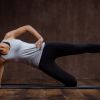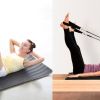Pilates Without Reformer: 12 Exercises You Can Do at Home!

Doing the exercises on the Pilates Reformer is very effective, interesting, fun, and invigorating at the same time. However, with a busy schedule, attending Pilates Reformer classes may not be as regular as you have wanted it to be. Buying Reformer equipment is not only expensive and impractical as it requires a lot of space, but it also requires deeper knowledge to do the exercises safely on your own.
Pilates exercises can be done without the Reformer equipment. All you need is an exercise mat, an elastic band, and a towel to complete a Pilates routine. You will still be able to stretch and strengthen your whole body and at the same time, work with your posture.
Let me give you a list of Reformer exercises that you can do at home or anywhere without the need for the Reformer machine. All you need is an exercise mat, a towel or a clean rag, and an elastic band to do these exercises. As for your towel or rag; look for a fabric that slides easily on the floor otherwise, it will not work.
It is best if you have already attended Pilates Reformer classes when doing these exercises as you have an idea of how it feels doing them on the machine. However, you can still do them without prior experience.
If you are very new to Pilates, I suggest you should work first on doing the basic Pilates mat exercises to build up your foundation. Here is an article I wrote for my UMove Fitness website about a full-body Pilates routine that you can do at home. If you are not familiar with the Pilates Reformer yet, here is an article you can read about how versatile this equipment is and what positions you can be in to use it.
Here are the Reformer exercises that you can do at home:
Leg and footwork with bands
When you do a classical routine on the Pilates Reformer, the leg and footwork series will be your first set of exercises. It is a good warm-up and at the same time, it works very well on aligning your posture before you proceed to more challenging movements.
Here are a few important points to take not before you do these exercises:
- Keep your pelvis stable when moving your legs in these exercises
- Work on both legs evenly as there is a tendency for you to work more on one side.
- Your shoulders, head, and neck will be off the whole time doing these exercises, so keep your abs engaged and the lower back flat, especially when you are extending the legs forward to protect your spine.
- You start with your hips and knees at a 90-degree angle and you will straighten your legs forward to a 45-degree angle with all the variations
- Make sure that the band is placed securely on your feet as it can slip and recoil back to your face as you extend your legs.
- You can repeat each movement around 6-10 times depending on your strength level.

Footwork 1: Heels
Hold each end of the band with both hands and place your heels securely at the center of the band with your ankles fully flexed the whole time so your ankle dorsiflexors (shin muscles) are engaged.
Straightened your legs aiming to reach with your heels forward and bend back to your starting position.

Footwork 2: Arches
Place the band at the center of your feet where the deepest part of your foot arch is. Curl your feet so they will form a letter C all throughout the movement. This will engage the intrinsic muscles of your feet.
Bend and extend the legs in the same manner.

Footwork 3: Prehensile
The foot position is almost the same as the arches except that the band is placed at the balls of your feet and your toes have to curl stronger to attempt to grip the elastic band.

Footwork 4: High Heels
You will place the band on the balls of your feet with your toes pointing backward and ankles plantarflexed (high heel position).
Bend and extend your legs in the same manner as the other movements.
As the name of the exercise implies, “Footwork”, which means you have to pay attention to the position of your feet to get the full benefit of these exercises.

Hundreds
One of the most popular Pilates exercises is the Pilates hundreds which can be done on the mat as well. We will simulate the Hundreds version on the Reformer to have a fuller experience of the workout.
You will need the band for this movement and an anchor point behind you at around hip height so you can loop the elastic band around.
Start lying down on your back with your hips and knees at a 90-degree angle while holding both ends of the band with both hands. Curl your head, neck, and shoulders and pulling the end of the bands down close to your hips.
Pulse your hands vigorously 6 inches up and down by the sides of your hips as you work on your Pilates percussive breathing.
The intensity of the workout depends on the angle of your legs. The closer your legs to the floor the harder it will be.
Repetition: Aim for 100 pulses… that’s how the name came about. If it is too hard, you can start with lesser reps and gradually increase it as you get stronger.
Pelvic press
This will be an interesting version where we will use a towel under your feet. But first, it is essential to understand the basic articulation of your spine before doing this movement. Holding a strong tuck on your hips will make this exercise very effective to work on your buttocks and hamstrings. Here is a video on my YouTube channel where I discuss the Pelvic press (also known as Shoulder bridge if done on the floor) breakdown. Watch the video so you will have a better understanding of the exercise.
Start lying down on your back with your knees bent and feet over the towel. Curl your spine up into a shoulder bridge position and hold a strong tuck on your buttocks and contract your abdominal muscles at the same time.
Extend your legs forward sliding your towel over the floor while maintaining the rest of the body still. Then slide your feet back to the starting position.
Repetition: Aim for 4 to 5 slides.
You should feel your buttocks and hamstrings more when doing this movement. If you feel that you are working more with your lower back, try not to lift too high, and check if you are tucking your buttocks enough. You may need the guidance of an experienced Pilates teacher if you feel that it’s straining your lower back.

Eves lunge
This Reformer exercise is very effective to stretch your hip flexors and strengthen the buttocks at the same time. The good news is, you can modify this movement by using a towel to substitute the function of the moving carriage. This is how you do it:
Stand with your right foot in front and your left foot 12 inches behind on a towel in a high heel position.
Slide your left foot back while keeping your posture upright. Contract your abdominal muscles and buttocks simultaneously. Allow your right leg to bend naturally depending on you far you go with your left foot.
Slide your left foot back to the starting position. Repeat for 5 to 8 times then change sides.

Elephant stretch
If you want to stretch your hamstrings differently and effectively, then this exercise is a good one to try.
Place your hands on the floor around 2 or 3 steps in front of your feet. Keep your knees bent slightly as you hold this position.
Reach your buttocks backward by pushing with your hands, while your knees are still bent.
Then straighten your knees while you still keep reaching with your buttocks to the back.
If it is not possible for you to straighten your knees, you can move your hands forward. The further your hands from your feet the easier it will be. Adjust accordingly, remember your hand placement and gradually progress over time by bringing the gap closer.
Repeat this movement 6 to 8 times and try to make every stretch count by holding it for a second or two before you release the stretch. It is important for you to understand how to move properly with this exercise so pay attention to the details and repeat more if necessary.

Knee stretch
This is an arm, core, and legs exercise combined together. And it’s a fun one as well.
Go into an all 4s position on the floor with your feet on top of the towel. Lift your knees off the floor aiming to keep your hips and shoulders at the same level. You may want to spend some time with this position to understand it better and to develop better awareness.
Slide your feet to the back until you end up close to a plank position, then pull it back to the front.
Make sure that your hips and shoulders stay on the same level as you do the movement. Contracting your abs and arms strong will help you stabilize the torso.
Repeat this movement 6 to 8 times.

Stomach massage
This is another exercise that is unique only to Pilates. And yes, it is an exercise, not a massage.
You start by sitting on the edge of your mat, legs bent in a diamond shape, heels together, and your feet on the towel. Make sure to really sit upright as you hold the starting position.
Slide your feet forward to straighten your knees holding your sitting posture as upright as possible. Slide back your legs back in and repeat the movement 6 to 8 times. You can keep your arms on the floor or extended forward as you do the full movement.
Straps with arms
There are many versions to work your arms on the Reformer straps. And it can be done sitting, kneeling, or standing. We’ll explore more on the kneeling version in this article.
These 3 versions of arm work are roughly similar with their intent for the exercises, here are some points to understand them better:
- Anchor your band around two feet from the floor and hold both ends of the band with your hands.
- You can adjust the tension of the band by holding a shorter length or moving further from the anchor point.
- These exercises work more on your posture than the arms, so focus more attention on how you keep your posture upright in the kneeling position. Keep your abdominals working and tucked in, your shoulders open and down, and lengthen your spine all throughout the movement.
- Repeat each movement around 6 to 8 repetitions.

Sphinx
Start in a kneeling position facing away from the band, with your hands facing down holding the ends of the band. Keep your elbows bent close to the side of your body and your forearm parallel to the floor.
Extend your arms forward around shoulder level height and bend back to your starting position. Don’t forget to keep your posture alignment straight at all times.

Beseech
The same movement as the sphinx except for your hands to be facing upwards. It is good to target a different hand position, especially when you are working with your posture. The more aware you are with your hands, the better you can control your shoulder posture.

Hug a tree
Start with your arms open to the sides around shoulder level height and slightly bent on the elbows.
Pull the ends of the band to close your arms as if you’re hugging a big tree in front of you. Open it back to your starting position making sure to keep your posture upright and your shoulders opened as you do the movement.

Chariot Pull
Kneel down facing the band and holding its ends with your elbows straight.
Pull the bands back as far as you can without compromising your posture. Try to open your chest as much as possible as you pull the band backward. Then return back to your starting position.



